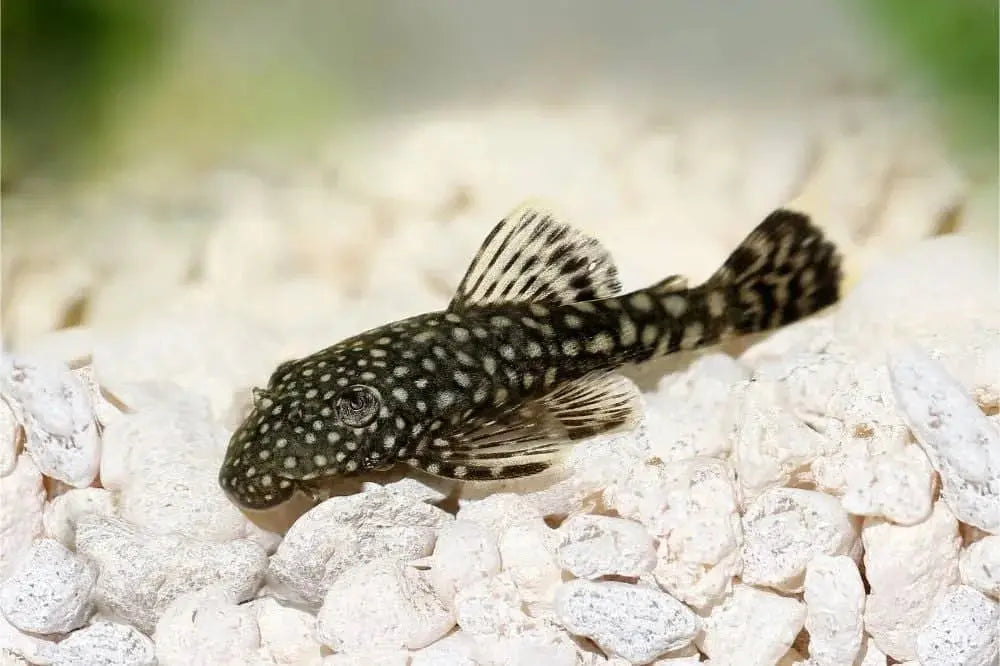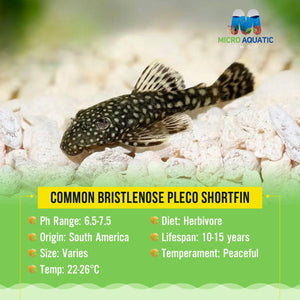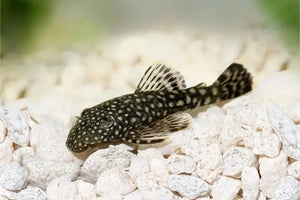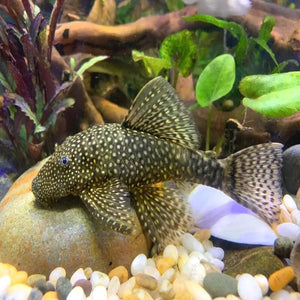Buy 2 Get 1 Free Algae Eater -Common Bristlenose
Order today - receive it in as little as 3-5 days.
Return within 30 days of purchase. Duties & taxes are non-refundable.
Guarantee Safe Checkout
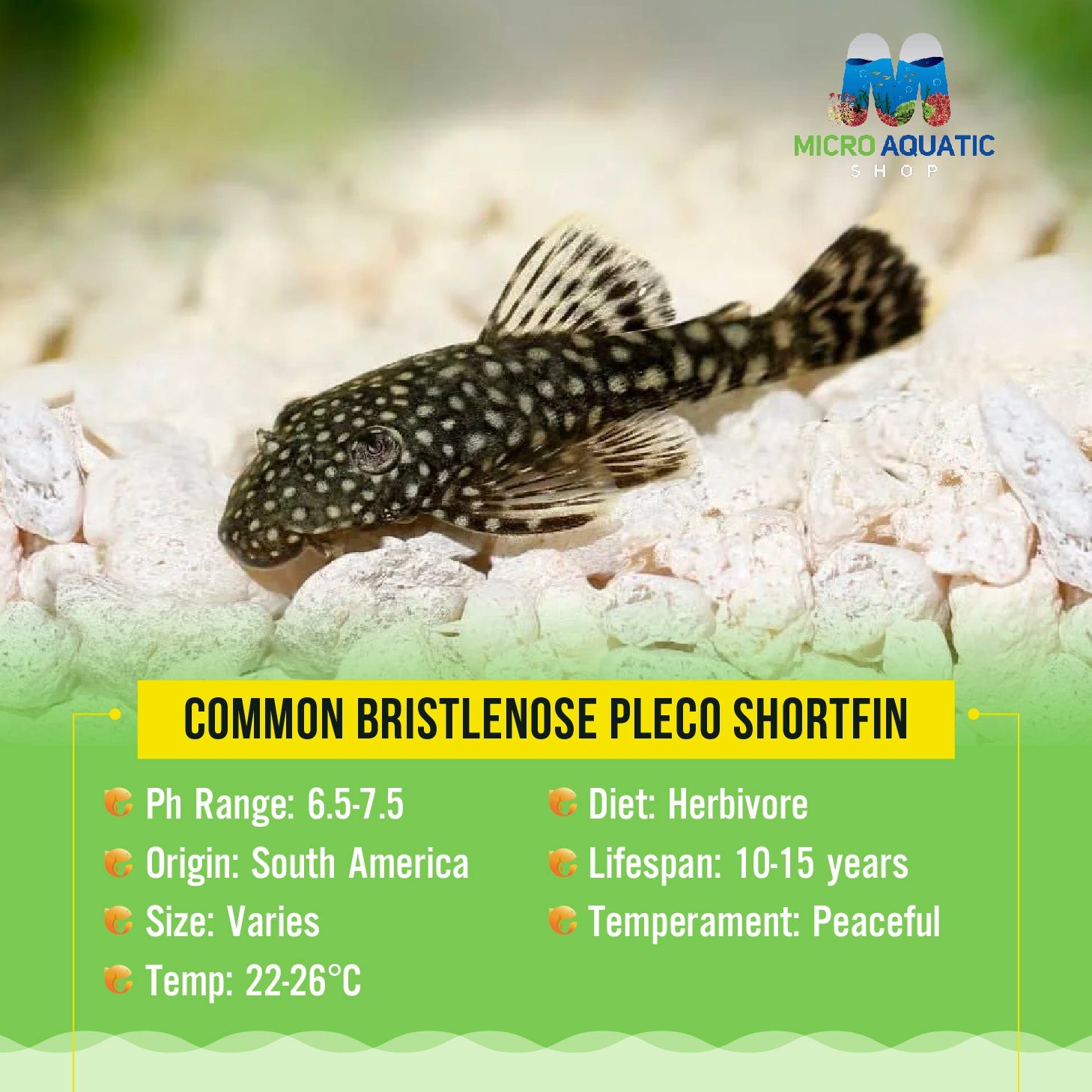
Buy 2 Get 1 Free Algae Eater -Common Bristlenose
Pleco Bristlenose (Ancistrus) - Hardy Algae Eater for Your Tank
Exploring the world of home aquariums is fascinating. We're excited to tell you about the Pleco Bristlenose. Known as Ancistrus, these fish are great at cleaning algae. They add a tropical vibe to any tank.
The Bristlenose Pleco rests gracefully in a lush aquarium, surrounded by vibrant green foliage and soft lighting, highlighting its unique bristly features and patterns, creating a serene underwater atmosphere.
Key Takeaways
-
The Pleco Bristlenose is a resilient addition to any freshwater aquarium.
-
Ancistrus species are known for their effective algae-eating habits.
-
These tropical fish add personality and contribute to a healthy tank environment.
-
Understanding the care of Pleco Bristlenose is essential for their wellbeing.
-
Integrating plecos into your aquarium can be a rewarding experience if done correctly.
Introduction to the Bristlenose Pleco
Meet the Bristlenose Catfish, a favorite among tropical fish lovers. They stand out with their distinctive look. Plus, they're great for aquarium maintenance. They help fight algae, keeping tanks clean and healthy.

Bristlenose Pleco with white spots on its body, resting on a gravel substrate in the aquarium.
The Bristlenose originates from the Amazon Basin's waters. They are perfect for new and seasoned fish keepers alike. Thanks to their hardiness and easy care, they fit well in most freshwater tanks. They're smaller than other plecos, growing up to 15 centimeters.
What makes Bristlenose Catfish special is their unique mouth bristles, especially in males. These bristles not only look cool but also help them clean the tank's bottom.
For the best care, know their diet needs. While they love algae, add plant-based foods to their meals. They like living in setups that remind them of home, with lots of hiding spots and a bit of water flow.
Here's why the bristlenose is a top pick for any tank:
-
Efficient Algae Management: They tirelessly work to scrape algae off tank surfaces.
-
Suitable for Smaller Tanks: Their compact size makes them perfect for aquariums as small as 20 gallons.
-
Interesting Appearance: Adds character to your aquarium with their unique bristles and varied coloration.
Adding a Bristlenose Pleco makes aquarium maintenance easier. It also adds beauty and function to your tank.
Understanding the Ancistrus Species
The Ancistrus species, also known as the Bristlenose or bushynose pleco, is captivating. They play a key role in the ancistrini tribe as efficient bottom feeders. This makes them stand out in the world of aquarium care.
Both newbies and pros in aquaristics find ancistrus valuable. They not only clean algae but their unique looks add beauty to any tank. Ancistrus are also smaller than other plecos, fitting well in compact tanks.
Here are some special traits of the ancistrus:
-
Their faces sport noticeable bristles, especially the males.
-
They do well in various water settings but like slightly acidic to neutral pH.
-
While they love algae, they also need veggies and specific pellets in their diet.
-
They're peaceful, getting along with many fish types.
Comparing the ancistrus to other plecos shows their uniqueness:
|
Feature |
Ancistrus |
Other Plecostomus |
|
Size |
Up to 15 cm |
Up to 60 cm |
|
Diet |
Algae, vegetables |
Algae, detritus |
|
Bristles |
Pronounced in males |
Seldom prominent |
|
Tank Requirements |
Smaller, complex environments |
Larger, minimal environments |
To sum up, ancistrus are crucial in balanced aquariums. They offer beauty and utility, keeping tanks clean and healthy. They are a smart pick for anyone wanting a vibrant aquatic space.
Ancistrus species, Pleco Bristlenose, in a vibrant freshwater aquarium environment, surrounded by lush green aquatic plants and decorative rocks.
Pleco Bristlenose, Ancistrus
Welcome to the fascinating world of the Bristlenose Pleco, a favourite freshwater aquarium fish among aquarists worldwide. These fish, known as Ancistrus, are not only captivating but vital for aquarium maintenance. We will explore these remarkable algae eaters, their homes, and their importance to water habitats.
Identifying the Bristlenose Pleco
To identify a bristlenose pleco, note their unique bristles on the snout, especially in males. They have a flat body covered in bony plates, helping them stick to surfaces. Their colours, ranging from dark brown to grey with light spots, act as natural camouflage.
Natural Habitat and Behaviour
The ancistrus natural habitat is found in South America's freshwater rivers and streams. Bristlenose Plecos enjoy shady spots under logs or in crevices, which are crucial for their health. To keep them healthy, replicate this setting in your aquarium with plenty of hiding places and a mild current.
The Role of Bristlenose Plecos in Aquatic Ecosystems
Known as outstanding algae eaters, Bristlenose Plecos are vital in keeping aquariums clean. They eat algae to prevent overgrowth and maintain ecological balance. Their role in breaking down detritus also supports a balanced nitrogen cycle, key for aquarium maintenance.
|
Feature |
Description |
Function |
|
Bristles |
Prominent on males; aid in camouflage and defense |
Helps deter predators and rivals |
|
Body Shape |
Flattened with bony plates |
Allows attachment to surfaces and provides protection |
|
Colour |
Varies from dark brown to grey, often speckled |
Enhances survival through effective camouflage |
The Bristlenose Pleco is a must-have for any freshwater tank, providing beauty and functional benefits. Understanding their background and habits will help them flourish in your aquatic home.
Benefits of Having Bristlenose Plecos in Your Aquarium
Adding Bristlenose Plecos to your aquarium improves its ecosystem and look. These fish are great at eating algae, keeping the tank clean. This means you won't have to clean the tank as often. They're a key addition to any community tank.
Bristlenose Plecos are peaceful, which makes them great mates for other fish. They help keep the peace in the tank. It's easier for all your fish to be happy and healthy with them around. They fit in well, helping to create a balanced tank.
-
Efficient Algae Management: Bristlenose Plecos control algae growth, keeping tank walls and substrate clean.
-
Low Maintenance: They are easy to look after, needing only basic care. This makes them ideal for any fish keeper.
-
Community Friendly: Their gentle nature means they get along with most aquarium fish, avoiding fights.
|
Feature |
Benefit |
|
Algae Consumption |
Less need for chemical cleaners |
|
Compatibility |
They can live with many fish kinds |
|
Size |
They don't need much room, suiting various tank sizes |
|
Appearance |
Their look adds interest to your tank |
Having Bristlenose Plecos in your tank makes it easier to care for and more lively. They keep your tank clean, freeing you from extra work. With them, your aquarium will be a thriving water world.
A Guide to Bristlenose Catfish Care
Welcome to our dedicated guide for Bristlenose Plecos lovers. We'll show you how to care for these unique fish. Creating the perfect home and food for them is key. We're excited to help you through every step.
Optimal Tank Conditions for Ancistrus
For healthy Bristlenose Plecos, getting the tank right is a must. They need water temperatures between 23 to 28 degrees Celsius. The pH should be between 6.5 and 7.5. Add rocks or driftwood to give them hiding spots. They like it best in dim light because they're night-time creatures.
Dietary Requirements of Bristlenose Plecos
The Bristlenose Plecos mainly eat plants. They love algae and veggies like zucchini, cucumbers, and shelled peas. For a treat, give them special bottom-feeder pellets sometimes. This helps them get all the nutrients they need.
Breeding Bristlenose Catfish
Breeding Bristlenose Plecos can be very rewarding. Make sure they have enough space and the right water to breed. Males make a nest in a hidden spot for the eggs. Keep the water clean and at the right temperature. This will help the eggs hatch and the fry grow healthy.
By taking good care of your Bristlenose Plecos, they'll do more than just survive. They're interesting to watch and can live a long time in your tank. With the proper care, they will be a joy in your tropical fish collection.
Common Misconceptions About Algae Eaters
When talking about algae eaters, like the Bristlenose Pleco, many myths exist. These creatures are crucial for aquarium maintenance, but often people get them wrong. Today, we're setting the record straight on the biggest myths.
-
Algae eaters clean all types of algae: Many think that once you add an algae eater to your tank, all algae issues will vanish. Different species, however, like different types of algae. Some may even ignore certain types.
-
Algae eaters don’t need additional food: Algae eaters do eat algae, but they also need a well-rounded diet. This includes algae wafers and veggies to keep them healthy.
-
One algae eater is enough for any tank: How many algae eaters you need depends on your tank's size and condition. Larger tanks or those with a lot of algae might need more than one algae eater.
To keep our algae eaters both happy and effective, we need more than just to place them in a tank. We must understand what they need and how they act.
Our goal is to give our algae eaters the best care, improving their work in aquarium maintenance and keeping the environment healthy. By busting these myths, we help our water buddies live better. This also leads to clearer, cleaner tanks for our enjoyment.
Introducing Bristlenose Plecos to Your Aquarium
Welcome to the journey of adding a Bristlenose Pleco to your fish community! These unique creatures are not just fascinating to look at. They also play a big role in keeping your aquarium clean and healthy. Let's go over the key steps to introduce and acclimate your new pleco smoothly.
Acclimating Your New Ancistrini
Being patient is critical when acclimating a bristlenose pleco. Start by floating the transport bag in your aquarium for about 15 to 30 minutes. This evens out the water temperatures and helps prevent shock. Then, slowly add small amounts of tank water to the bag every 5 minutes for around an hour. This helps the pleco get used to the pH and water conditions in the tank.
Companion Species for Bristlenose Plecos
Choosing the right companions is key for a peaceful tank. Bristlenose Plecos are calm and generally get along with other friendly tropical fish. The best tank mates for bristlenose plecos include:
-
Tetras
-
Guppies
-
Corydoras Catfish
-
Small Cichlids
These companions create a lively yet peaceful community. It's best to avoid larger, aggressive fish that might bully the pleco.
Maintaining a Healthy Environment for Your Pleco
Looking after your pleco means keeping the tank in top shape. Make sure to check the water often, keeping ammonia and nitrate levels really low and pH levels right for tropical fish. Cleaning the tank regularly and feeding the right amount are also crucial to keep your plecos and their mates happy.
|
Parameter |
Optimal Range |
|
Temperature |
23-28°C (73-82°F) |
|
pH Level |
6.5-7.5 |
|
Ammonia |
0 ppm |
|
Nitrate |
Less than 20 ppm |
By following these steps, your Bristlenose Pleco will have a great start in your tank. A proper beginning ensures a healthy and long life in your aquarium. This not only benefits your pleco but also makes your aquarium a more vibrant place.
Conclusion
Looking back, the Bristlenose Pleco has a key role in an Australian freshwater aquarium. They are great at eating algae and have a look and toughness that's special. This makes them a top choice for both new and expert fish keepers.
If you want to add these great cleaners to your tank, check out the Micro Aquatic Shop. It's at Unit 15, 2-8 Daniel Street, Wetherill Park, NSW 2164. They have healthy plecos and experts to help you.
Feel free to drop by or call us at (02) 8320 3037 for a chat. Whether it's setting up a new tank or improving an existing one, our team is here to help. We aim to make your tank lively and colorful with the best bristlenose plecos and advice.
FAQ
What makes the Pleco Bristlenose different from other algae eaters?
The Pleco Bristlenose stands out because it's hardy. This makes it perfect for many freshwater aquarium setups. They look unique with bristle-like whiskers around their mouth. Plus, they love eating algae, which helps keep tanks clean.
Can you describe the general characteristics of a Bristlenose Pleco?
Bristlenose plecos are small to medium fish. They have a wide head and a flat body. Males have bushy bristles on their snouts. Their bodies are protected by bony plates. They come in shades of brown, grey, or albino.
Where do Bristlenose Plecos naturally come from?
They're from South America, living in slow rivers and streams. These places have lots of wood and plants. Bristlenose Plecos find food and hiding spots easily there.
How do Bristlenose Plecos contribute to a healthy aquarium environment?
They eat a lot of algae on tank surfaces. This keeps algae growth in check. It helps maintain a balanced and clean tank environment.
What are the benefits of having Bristlenose Plecos in my home aquarium?
They're easy to look after and get along with many fish types. They're peaceful fish. Bristlenose plecos also help keep algae under control, reducing cleaning tasks.
What are the optimal tank conditions for Ancistrus species?
They like tanks with many hiding places, like caves or driftwood. The water should be 23-28°C with a pH of 6.5 to 7.5. Good water filtration is also essential to keep their environment healthy.
What should I feed my Bristlenose Catfish to keep them healthy?
Aside from algae, give them a mix of sinking algae wafers, fresh veggies (like zucchini), and sometimes protein (like bloodworms). This varied diet keeps them healthy.
Can you offer advice on breeding Bristlenose Catfish?
For successful breeding, keep the tank clean with lots of hiding places. The male guards the eggs in a cave until they hatch. Correct water conditions and diet are vital for breeding success.
What are some misconceptions about algae eaters like the Bristlenose Pleco?
Many think plecos only need algae to live, but they need various foods to stay healthy. They also can't keep a tank clean by themselves. They help, but can't replace regular cleaning.
How do I introduce a new Bristlenose Pleco to my aquarium?
Gradually acclimate them. Float the bag in the tank to even out the temperature. Then, slowly mix in tank water to the bag over an hour. It reduces stress from new water conditions.
What are suitable companion species for Bristlenose Plecos?
They do well with peaceful fish like tetras, guppies, and mollies. Avoid aggressive fish that could bother them. Bristlenose plecos are calm creatures.
What regular maintenance routines should I follow to keep my pleco healthy?
Change the water regularly and check the water quality. Keep the pH, nitrite, and ammonia levels in check. Make sure their diet is balanced. Clean the tank often to remove waste and leftover food. These steps keep your pleco healthy.
| Quantity |
1 fish 2-3cm juvies young, Buy 2 get 1 free bristlenose |
|---|

